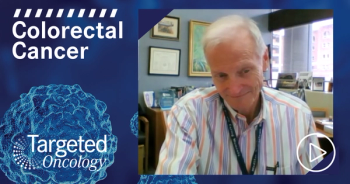
Trifluridine/Tipiracil: Benefit Vs Risk
Marwan G. Fakih, MD:The patient proceeds with TAS-102 as a third-line therapy. In this particular setting, I would bring the patient back after 2 weeks of treatment, day 15, for assessment. We obtain a CBC. The patient will come back again on day 1 of cycle number 2 and, again, we repeat the CBC with differential. The patient does not typically need to be seen more than an every-2-week basis in this particular setting. And, the likelihood of neutropenia is highest at the end of the cycle of treatment or when the patients present for day 1 of cycle number 2.
While fatigue may be common in the setting of TAS-102, the likelihood of that fatigue being grade 3 is actually very, very low. Less than 5% of patients will have severe fatigue. Most of the fatigue is grade 1 or grade 2, meaning it does not interfere with activities of daily living. In my patients who receive TAS-102, we typically see that the fatigue is typically transient, lasting for a few days. It’s not lasting for the whole 28 days. As long as the fatigue does not interfere with activities of daily living and is transient, I do not recommend any dosing down of TAS-102. The main reason for such is that the benefits of TAS-102 have been seen in association with grade 3 neutropenia, which suggests that a full dose may be important. Dosing down until we have no side effects or very little side effects may actually lead to lesser efficacy.
Are there any predictive markers of response for patients with advanced disease who have progressed on standard cytotoxic chemotherapy and anti-EGFR treatments? There are no predictive markers for benefit for TAS-102 or for regorafenib. In other words, what we know works as a biomarker of response for anti-EGFR therapywhether that be RAS mutation and, questionably as well, BRAF mutations—does not apply for TAS-102. TAS-102 has been shown to be effective equally in patients with RAS wild-type tumors as well as RAS-mutated tumors. The same argument can be made for regorafenib. What we know, however, is that both TAS-102 and regorafenib were investigated in the setting of an ECOG performance status of 0 and an ECOG performance status of 1. These drugs are indicated best in patients with an ECOG performance status of 0 and ECOG performance status of 1. I think more studies need to be done and investigated in the setting of ECOG performance status of 2. Those are not really a small portion of our patients, and it’s important to identify how much benefit we can see with TAS-102 and regorafenib in those settings.
Case Scenario 2:
- A 57-year old man presented for routine colonoscopy and was found to have a descending colon moderately differentiated adenocarcinoma. CEA pre-operatively was 6.
- Laparoscopic colectomy with colo-colonic anastomosis was performed. Final pathology showed a T3N2a (stage IIIb) lesion with 5/20 LNs positive. There was lymphovascular but no perineural invasion.
- Mutation testing revealed a KRAS mutation. The tumor was MSS.
- His ECOG performance status was 0.
- Following surgery, he was given adjuvant therapy with FOLFOX for 12 cycles with oxaliplatin help during the last two cycles because of grade 2 neuropathy.
- Six months later, follow-up imaging revealed recurrence and multiple metastatic hepatic lesions.
- The patient was started on FOLFIRI plus bevacizumab.








































